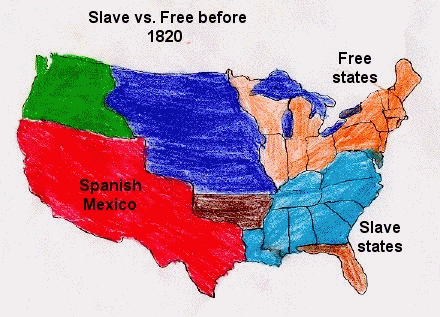
Topic: Missouri Compromise

Topic: Missouri Compromise
| Table of Contents | |
| Overview
Vocabulary Terms and Identifications Quiz |
Important
Maps
Biographies of Key Historical Figures Resources |
Overview: In 1793, Eli Whitney invented the cotton gin which increased the need for cotton. The South increased its cotton production by way of the slaves that it held within its territory. When Missouri applied for statehood as a slave state the balance of power would be upset. The Northern states would not allow themselves to be outnumbered in the US Senate, where each state has an equal vote of two senators. The Missouri compromise let Missouri into the Union as a slave state. Maine was separated from Massachusetts and admitted into the Union as a free state. The compromise bill, also called the Omnibus Bill, passed in 1820. The compromise also drew a line across the Louisiana Purchase at 36 degrees latitude and 30 minutes parallel line. North of that line slavery was banned. That left 12 free states and 12 slave states. To keep the balance in the senate, congress could not ban or prohibit the spread of slavery.
Vocabulary and Identifications
1) Henry Clay: Guided Congress through the compromise as Speaker of the House.
2) John Adams: He opposed the compromise because he did not believe the constitution gave the congress that power.
3) Resent: The south resented the new ban on slavery
4) Conflict: After the compromise passed the conflict on slavery was over for that time.
5) Sectionalism: Devotion to the interest of
one's own section rather than the nation as a whole.

Biographies
of Important People
| HENRY CLAY
Henry Clay lived from 1777 to 1852. In
that time period he contributed greatly to American politics. Especially when he
wrote and proposed the
Missouri Compromise. He also guided Congress through passage of the compromise.
Another way he helped the nation is by prohibiting slavery north of
the 36 degrees 30 parallel line as part of the Missouri Compromise. He settled a dispute between the
North and South over expansion of slavery, at least for a while. Then came the
Civil War in spite of his efforts.
|
Missouri Compromise
Quiz
Directions: Circle the correct answer.
1. In what year was the Missouri Compromise passed?
A. 1812
B. 1820
C. 1902
D. 1830
2. What degrees did the Missouri Compromise ban slaves?
A. 36 degrees 30 parallel line
B. 30 degrees 36 parallel line
C. 46 degrees 40 parallel line
D. 40 degrees 40 parallel line
3. What year was Missouri for admission into the Union?
A. 1817
B. 1818
C. 1816
D. 1819
Vocabulary
Directions: Circle the correct answer.
1. What does resent in the Missouri Compromise mean.......
A. The south disliked the new ban on slavery
B. The south liked the new ban on slavery
C. The north disliked the new ban on
slavery
D. The north liked the new ban on slavery
2. What does conflict in the Missouri Compromise mean......
A. North had problems with the North
B. North had problems with the West
C. North had problems with the South
D. North had problems with the East
Matching
Directions: Put the correct letter to the right
number.
1. 1820
A. 36 degrees 30 parallel line
2. Latitudes for it
B. Banned
3. Slavery
C. Missouri Compromise
4. Cotton gin
D. Brought up compromise
5. Henry Clay
E. Separate cotton from the seeds
Answers
For Multiple Choice
1. B
2. A
3. B
For Vocabulary
1. C
2. C
For Matching
1. C
2. A
3. B
4. E
5. D
Resources:
Missouri Compromise
World book, 98
author, William Foley
Henry Clay
World book
Daniel Walk Clayer Howe
Missouri Compromise
Why We remember
Herman Viola
This page is part of a web project developed by Mr. Cassutto's 7th grade US History class at Sterling Middle School
Student authors:
By: Patrick M.
Samuel E.
Brian P.